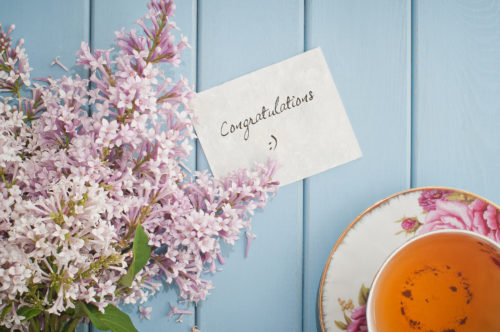A congratulations letter is a simple, elegant, and thoughtful way to compliment a friend, family member, or co-worker on a recent achievement. Since a congratulations note can be used for a variety of reasons, it can either be created in the formal or informal realm.
In many cases, you may need to craft a congratulations letter at work to acknowledge a co-worker for what he or she has achieved. Letters like these make the workplace a positive and encouraging environment and allow you to form friendly relationships with your co-workers and clients.
A heartfelt congratulations can be expressed in different forms, including via email, through a note, or with a letter. In the workplace, an email is a common way to communicate with co-workers or clients and may be the delivery method you choose for your congratulations. However, the most common and traditional way to send congratulations is with a handwritten letter.
Table of Contents
When to Write a Congratulations Letter
In a workplace setting, a congratulations letter can help you recognize when an employee, client, or co-worker has achieved something extraordinary. There are many reasons you may decide to write a congratulations letter to someone, including:
- Getting a new job.
- Leaving a job.
- Finishing a big project.
- Getting a promotion.
Your acknowledgment of accomplishments through a congratulations email, note, or letter can make the person feel proud of their achievement. While a congratulations note is a small gesture, it can help this person understand that you recognize their hard work.
What a Congratulations Letter Should Include
Your congratulations letter should contain positive language that expresses your recognition of the recipient’s achievement and your appreciation for what they have accomplished. The specific content you want to include in your congratulations letter will vary depending on the organization you work with, the reason for the note, your company culture, and your relationship with the recipient.
However, whether you give your congratulations by email, note, or letter, there are a few elements you should be sure to include.
Greeting
First, you’ll need to decide how you want to begin your letter. In most cases, your congratulations letter will start with “Dear” followed by the recipient’s name. Always place a comma after the recipient’s name. This greeting is the traditional way to begin a letter and is generally considered a formal way to address someone. You may feel you can deviate from this type of greeting if you know the recipient well and your congratulations letter is meant to be informal.
A congratulations email may begin differently than “Dear” since email can sometimes be a more informal method of communication. With a congratulations email, you may feel more natural starting with “Hello” followed by the recipient’s name, or simply the recipient’s name. In a more informal email setting, you may feel you can begin your letter with a quick statement, such as “I just heard the good news!” or “You did it!”
General Statement of Congratulations
After your greeting, you should address the purpose of the letter. Instead of “How are you?” or another general question, begin your congratulatory statement. Since the sole purpose of this communication is to congratulate the recipient, don’t include information about other subjects — get straight to the point of congratulations. Explain why you’re sending congratulations. For example, “I just wanted to take a moment to say congratulations on your promotion.”
Personal Touch
Throughout your congratulations letter, it’s important to be sincere. You may not come off as sincere if you simply repeat your congratulatory statement over again throughout the letter.
Adding personal touches throughout your message ensures you’re showing your sincerity and is more effective at showing you acknowledge the recipient’s triumph. For example, “I know the competition was fierce, but your years of experience tackling tough and time-consuming projects really wowed the executives.”
Closing
The closing of your congratulations letter should not only include a sign-off with your name, but also an encouragement for the recipient. The exact closing phrase you use in your letter or email will vary depending on the circumstance.
If the recipient recently got a promotion or moved to a new company, you could close with “Good luck!” or “I wish you success in your new position.” Your sincerity can also be highlighted in your closing statement if you offer yourself as a resource. Ask if you can help with the recipient’s new venture in any way if necessary.
Congratulations Letter Sample
The following congratulations letter sample is one that would be sent to a co-worker after she received a promotion:
Dear Carol,
I just heard the great news! Congratulations on your promotion to Executive Assistant! Your hard work has really paid off and I know you’re going to shine in your new role. It’s been so inspiring to watch you work hard and achieve your dreams.
Good luck in your new position and please let me know if I can help you move into your new office.
Sincerely,
Trevor
You can deliver your congratulatory message by letter, email, or note, but the general format will remain the same. By sending out congratulations, you can make a co-worker, friend, employee, or client feel special about achieving an accomplishment. When you follow these guidelines for writing a congratulations letter, you’ll know you’ve expressed your sincere congratulations and recognition of a job well done.
Image Source: https://depositphotos.com/





